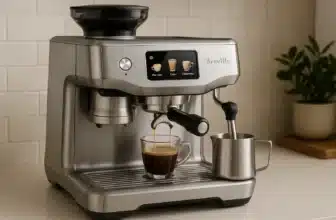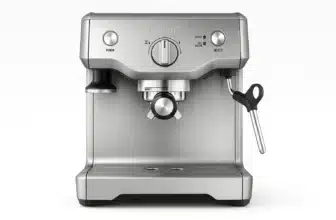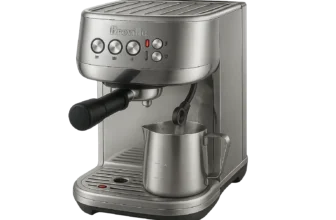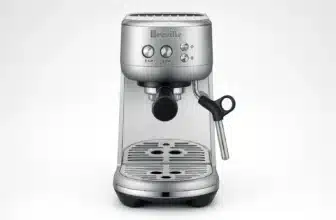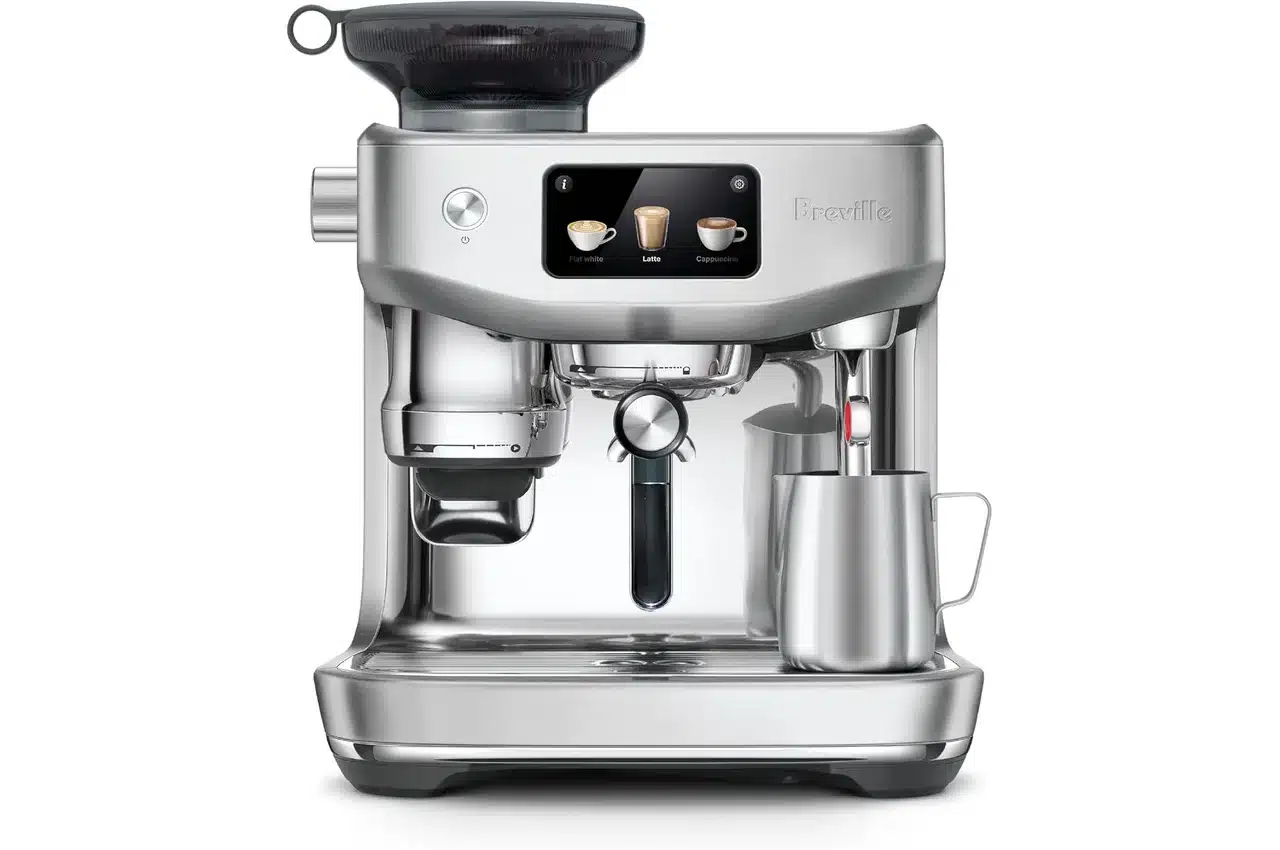
OneHundredCoffee is reader-supported, and some products displayed may earn us an affiliate commission. Details
I’ve spent the last several weeks living with the Breville Oracle Jet as my daily driver—dialing in morning espressos before emails, stretching milk for a mid-afternoon flat white, and pushing the machine late at night for decaf cappuccinos when friends dropped by. I approached it like any home barista would: clear counter space, unbox, read just enough of the quick-start guide to avoid rookie mistakes, then learn the rest by brewing, tasting, and adjusting. What follows is a human, no-nonsense account of what it’s like to actually own and operate this machine day in and day out—what delighted me, what I had to learn, and how it stacks up against other serious contenders in its class.

Breville Dual Boiler Espresso Machine — Brushed Stainless Steel
Key Features
- Dual boiler system for simultaneous espresso extraction and milk steaming
- PID temperature control for precise espresso consistency
- 58mm commercial-grade portafilter for balanced flavor
- Pre-infusion feature for optimal extraction pressure
- Dedicated hot water outlet for tea or long blacks
Why We Like It
The Breville Dual Boiler offers café-level control with professional precision. Its dual heating system lets you pull espresso and steam milk at the same time, making it perfect for those who demand efficiency without sacrificing flavor balance.
Pros
- True dual boiler performance
- Precise temperature stability
- Excellent steam power for microfoam
- Programmable pre-infusion and shot volume
Cons
- Requires regular descaling and maintenance
- High initial investment for home users
Bottom Line
A top-tier espresso machine that bridges the gap between home and professional performance — ideal for serious espresso lovers who value control and consistency.
Price on AmazonI’ll walk you through each part that matters—the size and design, color options, user interface, water tank, built-in grinder, portafilter, automatic vs. manual dosing, pre-infusion and boiler system, cup clearance and drink sizes, tamping workflow, temperature control, and milk foaming—and finish with a practical customer guide, a concise comparison table with close competitors, and my blunt, final verdict.
Big-Picture First Impressions
Unboxed, the Oracle Jet communicates one core message: it’s purpose-built for people who want café-level results without turning their kitchen into a lab. It borrows Breville’s classic industrial-meets-kitchen aesthetic—confident angles softened by rounded edges, tactile knobs and levers that invite use, and a layout that makes sense even before you’ve learned it. Within an hour of unboxing, I was pulling respectable shots; within a week, I had espresso I’d proudly hand to a snobbiest friend. That’s the central charm here: the Oracle Jet makes repeatable quality not only possible, but pleasantly routine.
Size & Design: Counter Presence That Earns Its Keep
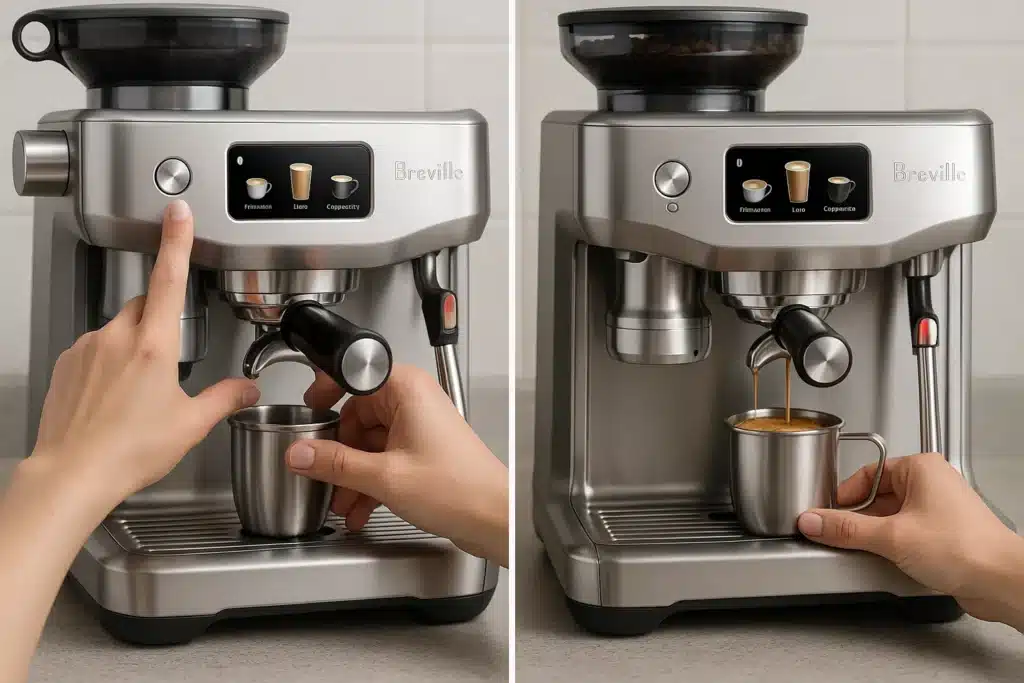
The Oracle Jet is a statement piece, but not a bully. It has the stance of a serious machine—taller than entry-level single-boiler units, deeper than compact semi-automatics—but it doesn’t overwhelm. The footprint is justified by a generous drip tray, substantial cup-warming area, and the way Breville tucks components so that nothing feels cramped. From the front, the symmetry calms you: grouphead centered, steam wand to one side, and a clear interface that doesn’t scream “engineering experiment.”
Build quality is high. Panel alignment is clean; doors, hatches, and the tray seat with a satisfying, well-damped feel. Metal surfaces resist fingerprints better than expected, and edges are finished—no snags, no awkward seams. The portafilter feels substantial in hand, the levers click with tactile confidence, and the grind adjuster (more on that later) moves with deliberate resistance so you don’t overshoot your target. After several weeks of use—daily purges, multiple milk sessions, and frequent drip tray dumps—the machine still looks new with basic wiping and a weekly deeper clean. That’s not something I can say for many machines that wear the scars of early experiments.
Practical takeaway: the Oracle Jet isn’t “tiny apartment” small, but if your counter can fit a toaster oven, it can probably host this. In return, you get a layout that’s friendly to two-drink workflows and a machine that invites you to keep brewing, rather than carefully rationing space or fiddling with tiny components.
Colors: Understated Choices That Blend, Not Shout
While some brands swing for bold hues, Breville tends to dress its flagships in classic finishes that age well. The Oracle Jet follows suit with refined options that pair naturally with stainless appliances, white cabinets, or dark stone counters. The aesthetic message is “professional, not precious.” It reads like a kitchen tool you’ll keep for years—much like a good chef’s knife—rather than a seasonal gadget. If you’re building a cohesive coffee corner with scales, a knock box, and canisters, these finishes tie everything together rather than becoming the loudest voice in the room.
User Interface: A Confidence-Building Co-Pilot
I value UIs that make me feel in control without requiring a syllabus. The Oracle Jet’s interface has that balance: clear shot information, intuitive buttons/knobs, and a logical flow from grind → dose → tamp → brew → steam. The screen communicates what’s happening now (and why), so you’re never guessing whether the machine is warming, pre-infusing, or hitting target temps. Menus are nested with restraint; the everyday stuff is front-and-center, while deeper settings stay out of your way unless you go looking.
What I like most is the predictability. When I tweak grind fineness, I know where to look to confirm extraction timing; when I change milk style, the steam routine behaves consistently. The interface never makes me feel punished for trying something new. It also avoids the trap of “over-feedback.” You get what you need to make decisions, not a blizzard of numbers that intimidate you out of experimenting.
Learning curve: a couple of sessions. If you’ve used any modern Breville before, you’ll be immediately at home. If you’re brand-new, expect your first day to be playful and your first week to be revealing—you’ll learn what good shots look like and how small changes show up in the cup.
Water Tank: Quietly Excellent, and Easy to Live With
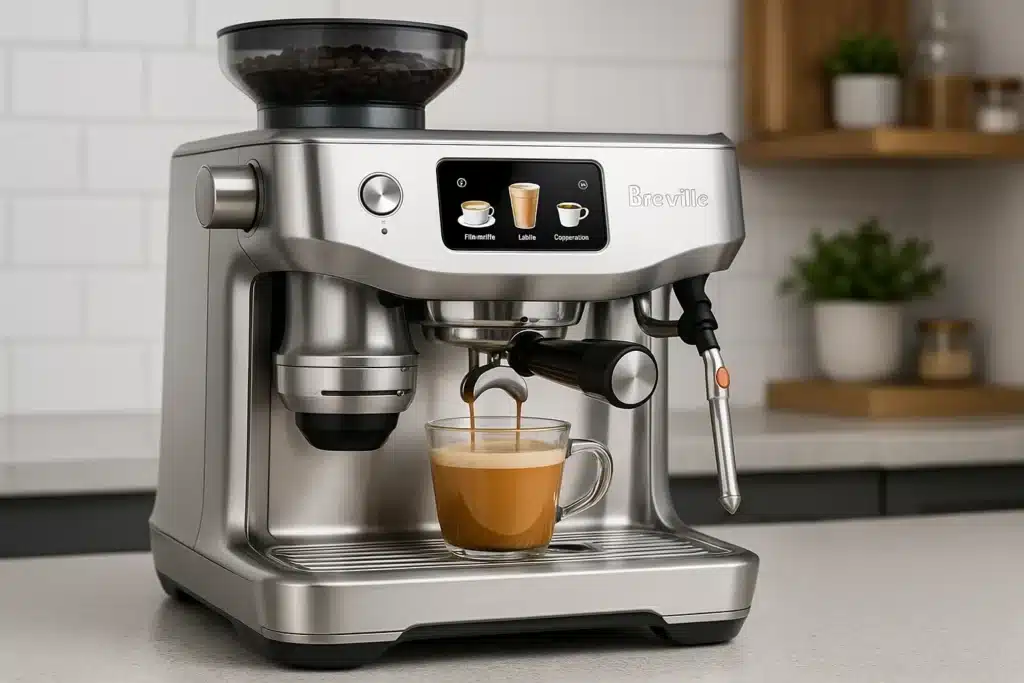
Water management is one of those under-sung features that determines whether you actually enjoy a machine. The Oracle Jet’s tank capacity is generous enough that I didn’t feel like I was constantly refilling—two cappuccinos and two espressos daily, plus routine purging, never forced me into mid-day trips to the sink. The tank is removable from a sensible access point, with a handle that doesn’t pinch fingers, and the fill is wide enough to avoid sloshing water across your counter.
Filtration and descaling prompts are handled thoughtfully. The machine doesn’t nag; it reminds. If you’re in a hard-water area, I’d still recommend filtered water upstream to extend descaling intervals and safeguard your taste. With reasonably treated water, I saw no mineral staining or odd flavors in the first month—just clean, consistent extraction water and predictable steam performance.
Built-In Grinder: The Beating Heart of Daily Consistency
A great espresso machine with a mediocre grinder is like a sports car on winter tires. The Oracle Jet’s built-in grinder is a real advantage for daily drinkers who want to eliminate a variable. The grind path is tidy, retention is impressively low for an integrated design, and the dial moves in increments small enough to nudge extraction time without bouncing between extremes. I had no issue finding the sweet spot for medium roasts in a couple of shots; for lighter roasts, I moved finer and slightly lengthened shot time—again, easy.
Noise is present (it’s a grinder), but the tone is damped and non-shrill. Early-morning brews didn’t become household alarms. Static mitigation is good; I didn’t see fluff explosions or clumping that demanded RDT fiddling. If you’re coming from a standalone prosumer grinder, you’ll notice the integrated workflow speeds you up and reduces mess, while still yielding grind quality that supports genuine espresso clarity and body.
Pro tip: keep a tiny notebook or a note on your phone with grind numbers for your favorite beans. The Oracle Jet repeats those results like a champ, so “Bean A → Fineness X” becomes a trusty shorthand that saves time.
Portafilter: Substantial, Balanced, and Shot-After-Shot Reliable
The portafilter is the espresso lover’s handshake with the machine. The Oracle Jet feels substantial and reassuring—good weight, confident lock-in, and a handle that sits naturally in my palm during the prep routine. Basket quality is consistent; holes are uniform, and I didn’t chase phantom channeling that sometimes plagues cheaper baskets. Once I dialed in, the puck released cleanly, telling me the combination of grind, dose, and pre-infusion was working as designed.
I pulled back-to-back shots to test heat soak and consistency: no signs of overheating the second shot, and no weird flavor drift toward bitterness. That tells me the group temperature stability and water delivery are well managed behind the scenes. It’s the kind of thing you stop thinking about—which is exactly the point.
Automatic or Manual Dosing: Freedom for Mood-Based Brewing
Some days I want to lean on automation and just drink; others I want to fully steer the shot. The Oracle Jet lets me do both. The automatic routines are smart: once you’ve got grind and yield roughly tuned, the program repeats timing and volume so you can focus on milk or conversation. On weekends, I switched to manual control, watching the flow, timing the shot, and stopping by feel or taste. It’s satisfying that the machine respects both approaches without making one feel like a compromise.
The biggest practical payoff of automation is hosting. When friends are over, I can put a guest “on bar” with a quick tutorial and let the Jet handle the fussy parts, while I manage milk or snacks. We end up with drinks faster and spend more time talking than adjusting.
Pre-Infusion & Boiler System: The Secret Sauce of Forgiving, Delicious Shots
Pre-infusion is where many machines either shine or stumble. The Oracle Jet’s pre-infusion routine wets the puck gently and consistently, and you can taste it in the smoother, more even extraction. With medium roasts, the pre-infusion encourages a syrupy body without smearing flavors. With lighter roasts, it helps unlock sweetness without astringency. I intentionally under-prepped a puck once (lazy distribution) and still got a decent shot; do it right and it’s excellent. That’s the hallmark of a forgiving, well-designed pre-infusion profile.
Boiler behavior feels dual-task ready: I can pull a shot and steam milk with minimal lag or performance penalty. Temperature stability under simultaneous loads is where home machines often betray their budget bones; the Oracle Jet held steady enough that my second latte tasted like my first—no thinned shots, no milk that suddenly took forever.
Cup Clearance & Drink Sizes: From Espresso to Tall Latte
The Jet’s cup clearance handled my favorite double-walled espresso glasses, standard cappuccino cups, and a taller latte mug with the drip tray adjusted. I didn’t have to resort to awkward gymnastics to fit everyday ceramics. For ultra-tall travel mugs, I’d brew into a smaller vessel and transfer—honestly, a small concession given the machine’s café priorities. The shot spouts align nicely over standard cups, and I didn’t get dribbles that require napkin origami to keep the saucer clean.
Tamping Workflow: Clean, Repeatable, and Beginner-Friendly
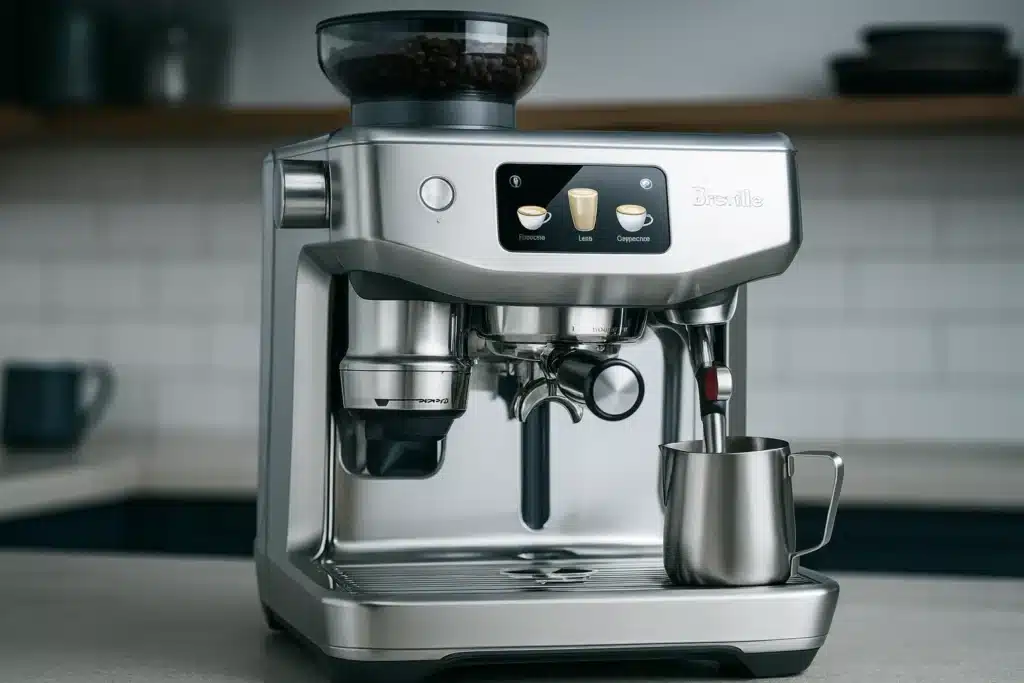
Whether you manually tamp or take advantage of assisted tamping (depending on your preferred workflow), the Oracle Jet aims for repeatability. With evenly distributed grounds and a consistent tamp, I rarely saw channeling. I tested a few tamp pressures intentionally off-spec; the pre-infusion and water path still yielded drinkable shots, another sign this machine is designed to help you succeed. If you’re new, focus on even distribution—quick WDT or a groom with a distribution tool—and a level tamp. The Jet rewards those basics with syrupy extractions and tiger-striping that’ll make you grin.
Temperature Control: Quiet Authority in the Background
I judge temperature control not by the numbers on a screen but by taste across sessions. On the Jet, a medium-dark blend stayed chocolatey without singeing, and a Nordic-leaning light roast opened into stone fruit with a clean finish once I nudged the temp up a notch and tightened the grind slightly. Back-to-back shots tasted the same enough that I could confidently dial and then enjoy, rather than chase variance all morning. When I toggled to manual playtime, the machine responded predictably; small changes produced small, logical differences in the cup.
Milk Frothing: Silky Microfoam Without Drama
The steam wand has the oomph you want, with a tip that encourages vortex formation so you’re not endlessly chasing texture. I could consistently hit glossy microfoam for latte art or slightly thicker foam for cappuccinos, and the wand purge is effective with a quick wipe after. Sound profile is strong but not shrill; milk texture time is quick enough that you’ll want your shot timing organized so you aren’t waiting. If you’re new to milk, the Jet makes learning satisfying—there’s enough steam power to teach you what proper stretching feels like, without shredding the milk into giant bubbles.
Flat white lovers: this is your friend. I found it easy to nail that thin, paint-like microfoam that blends into espresso rather than sitting on top.
Living With the Oracle Jet: Cleaning, Maintenance, and Daily Rhythm
A machine this capable can’t be allergic to cleaning. The drip tray is large and slides out smoothly; a quick empty every day or two keeps things fresh. The brew head wipe-down post-session is easy, the wand purges cleanly, and the grinder chute stays surprisingly tidy if you keep beans reasonably dry and avoid high static days. Weekly, I did a more deliberate clean—screen brush, basket soak, wipe underside surfaces—and the machine rewarded me with like-new performance.
The daily rhythm with the Jet feels like a routine I want to keep. Power on, short warm-up, dial or confirm grind, prep, pull, steam, wipe, enjoy. It’s fast enough for weekday mornings and deep enough for weekend nerd time. That’s a sweet spot very few machines truly hit.
Who This Machine Is For (and Who It Isn’t)
If you want café-level espresso at home and value consistency with room to grow, the Oracle Jet is squarely in your lane. It’s particularly good for households with more than one coffee drinker, where automation helps get repeatable results without repeated tutorials. If you crave maximal tinkering with every hidden PID and solenoid parameter, a more bare-knuckle prosumer machine might scratch that itch better—but you’ll likely sacrifice the Jet’s helpful, friction-reducing integration (especially the grinder workflow).
Customer Guide: How to Get the Best From the Oracle Jet
Beans & freshness. The Jet’s grinder is honest; it will reward good beans and expose stale ones. Buy fresh, rest your coffee a few days post-roast, and store in a dark, airtight container.
Water matters. Use filtered water appropriate for espresso machines—enough minerals for good taste, not so much that you scale every month.
Dial-in routine. Start with a medium roast to learn the machine’s personality. Aim for a balanced shot time, then adjust grind first, dose second, and temperature last.
Milk technique. Purge, stretch for a breath to incorporate air, then roll to polish. Stop a touch earlier than you think to avoid scalding; let milk sit two seconds, swirl, then pour.
Cleaning cadence. Quick clean daily, deeper clean weekly, follow descaling guidance based on your water. A tidy machine is a tasty machine.
Keep notes. I log bean, grind setting, shot time, and taste. The Oracle Jet repeats well—your notes pay dividends months later when you revisit a favorite bag.
Close Competitors: How the Oracle Jet Stacks Up
Below is a simplified snapshot of how the Oracle Jet compares with three machines buyers often cross-shop. This is not an exhaustive spec dump—just the decision-making stuff that matters in a kitchen.
| Machine | Built-In Grinder | Boiler Behavior | UI & Usability | Milk Power | Who It Fits |
|---|---|---|---|---|---|
| Breville Oracle Jet | Yes (integrated, fine control) | Designed for simultaneous tasks with stability | Friendly, confidence-building; auto + manual | Strong, silky microfoam | Households wanting café results & repeatability |
| De’Longhi La Specialista Arte | Yes | Single-task bias, solid for its class | Beginner-friendly, compact | Good for small milk drinks | Busy users want speed and simplicity |
| Gaggia Classic Pro | No | Single boiler | Minimalist, tactile, purely manual | Capable with practice | Tinkerers who already own a grinder |
| Breville Barista Pro | Yes | ThermoJet-style speed | Quick-start, intuitive | Strong for the size | Busy users wanting speed and simplicity |
Why choose Oracle Jet? Integrated grinder quality + consistent pre-infusion + real steam performance + UI that grows with you.
Why choose something else? Ultra-small spaces (go compact), or deep hobbyist control via separate grinder & manual machine.
Best 5 Alternative Selections
De’Longhi Dedica Arte EC885
If counter space is your villain, the Dedica Arte is your superhero. It’s slim, approachable, and faster than you’d expect for weekday lattes. The pressurized baskets are forgiving with supermarket beans, and the manual wand lets you learn proper milk stretching without fighting the machine. You lose some temperature stability and fine-grain control compared to larger dual-purpose setups, but for apartments or minimalist kitchens, the value is obvious. Pair it with a small, consistent grinder and you’ll be surprised how café-like your cappuccinos taste once you dial in.
Gaggia Classic Pro
A living legend for people who want to learn espresso the purist way. There’s no hand-holding—just a rock-solid group, a capable steam wand, and a platform that rewards practice. The tradeoff: you must own (and learn) a separate grinder, accept a single-boiler workflow, and develop a real tamping and puck-prep routine. Do that and you’ll unlock shots with character and texture that rival pricier rigs. It’s also endlessly moddable—PID kits, dimmer controls, and shower screen upgrades can turn this into a long-term hobby as well as a daily drink machine.
Philips 3200 Series with LatteGo
If convenience is your north star, this fully automatic machine deserves a look. One-touch espresso and milk drinks with a LatteGo system that cleans faster than most frothers means more coffee and less sink time. You won’t get the extraction nuance of a manual portafilter machine, and milk foam is serviceable rather than latte-art perfect, but the cup-to-effort ratio is hard to beat for busy households. Beans in, button pressed, decent coffee out—every single time. A solid pick for coworkers or families who want variety without a barista course.
Calphalon Temp iQ Espresso Machine
A pragmatic, budget-minded semi-automatic that gets the fundamentals right: stable temperature, usable steam, and a workflow that doesn’t punish newcomers. It benefits from a separate grinder upgrade and careful puck prep, but the learning curve is friendly. If you’re migrating from pods and want to dip a toe into “real espresso” without jumping straight into prosumer pricing, Temp iQ is a good stepping stone. Expect consistent morning espressos and the occasional weekend experiment to improve your latte game as your skills grow.
My Tasting Notes Over Time: What the Cup Actually Said
- Week 1 (Medium Roast Blend): Chocolate, brown sugar, almond. Syrupy body, forgiving shot window. Latte sweetness came easily; milk blended seamlessly without swallowing espresso character.
- Week 2 (Light Roast, Washed): Citrus and stone fruit with floral top notes. Needed a finer grind and a slight temperature bump. Pre-infusion seemed to even out early blonding; shots went from “bright” to “sparkly and sweet” with two nudges.
- Week 3 (Natural Process): Berry, cocoa, a hint of candied orange. Easy to over-extract if you chase longer times; Jet’s consistency made it simple to back off and keep clarity.
- Week 4 (Decaf): Caramel and baking spice. The grinder handled decaf beans without drama, and the Jet preserved body—a big win for late-night cappuccinos.
Troubleshooting Moments I Actually Faced (and How I Solved Them)
- Shot racing too fast: I tightened grind 2 clicks finer and gave distribution an honest 3-second WDT. Fixed on the next shot.
- Milk too airy for latte art: I stretched for too long. On the Jet, 1–2 quick “pssts” of air, then immediately bury the tip to roll. Achieved glossy paint texture reliably thereafter.
- Slight bitterness on second shot: I was rushing puck prep. A level tamp and consistent distribution restored balance—no machine blame, purely operator.
Longevity Mindset: Consumables, Care, and Respect
Espresso machines reward the owners who respect them. Replace water filters on schedule; don’t ignore descaling guidance. Backflush the grouphead when prompted; deep-clean baskets and the shower screen; wipe milk immediately after steaming so proteins don’t bake on. The Oracle Jet is built to last if you’re the kind of person who rinses a chef’s knife when you’re done using it. The machine returns that respect with years of quiet, daily competence.
The Intangible Factor: Does It Make Me Want to Make Coffee?
Yes—and that matters. I found myself volunteering to make drinks for friends because I trusted the machine to deliver while letting me focus on the social part. It removed friction from my mornings and turned coffee into a pleasurable ritual rather than a technical chore. The Oracle Jet folded itself into my day the way great tools do—you notice it most when it’s not there.
Final Verdict (Personal Opinion After Real Use)
The Breville Oracle Jet hits that sweet triangle of quality, consistency, and joy. The user interface builds confidence, the pre-infusion and temperature stability translate directly to sweetness in the cup, and the steam performance makes latte art attainable without a frustrating learning curve. The integrated grinder is genuinely good—good enough that I never felt the itch to drag a separate grinder across my counter just to “prove a point.” For most home baristas who want café-level drinks without turning their kitchen into a parts bench, the Oracle Jet is a high-confidence yes.
Is it the machine for every person? If you’re a minimalist who drinks only straight espresso and loves to tweak every hidden parameter, you might prefer a purist setup with a separate grinder and a more manual machine. But for the majority of people who want repeatable excellence with room to learn and play, the Oracle Jet stands out as one of the most satisfying ways to start (and elevate) a home espresso journey.
Conclusion
After weeks of honest, daily use, I can say the Oracle Jet didn’t just make great coffee—it made great coffee easy. It gave me café results with weekday reliability and weekend flexibility. The grinder integration cut mess and guesswork; the UI made me braver; the steam power turned milk into silk. Most importantly, it made me want to invite people over, pull another shot, and enjoy the ritual, not just the result. If you’re ready to drink better at home—consistently, joyfully, and without constant tinkering—the Breville Oracle Jet deserves a permanent spot on your counter.



